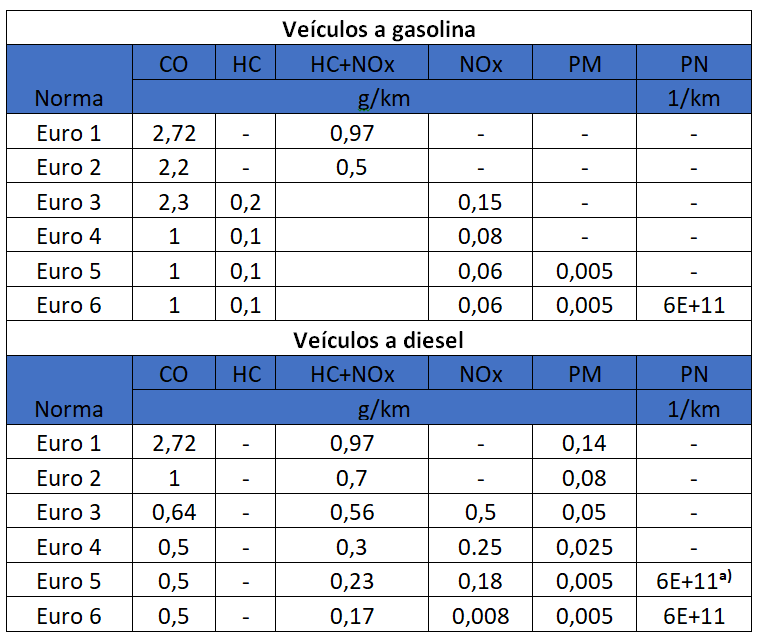In order for combustion to occur within an internal combustion engine, whether diesel or gasoline, two essential products are required: air and fuel.
In Image 1, on the left, the elements admitted by the engine, air and fuel, are presented, and on the right, the products released by the engine, recorded before the exhaust gas treatment system.

Figure 1 - Input and Output Elements
When discussing pollutant emissions, it is common to refer to some compounds, nitrogen oxide (NOx), hydrocarbons (HC), carbon monoxide (CO), and particles (PM). However, these are not the only elements released by the exhaust as visible in Image 1. And of those presented, not all are considered pollutants. Nitrogen, oxygen, water, and carbon dioxide (CO2) are not pollutants.
Although not considered a pollutant and not harmful when in high concentrations in the atmosphere, CO2 emissions are the main cause of the greenhouse effect and have therefore been increasingly limited. CO, HC, SO2, PM, and NOx directly harm health, mainly contributing to the onset of respiratory diseases.
Image 2 allows us to verify the differences in emissions from a gasoline and diesel vehicle.

Figure 2 - Emissions (Indirect Injection Gasoline vs. Diesel)
Observing the image, it is evident that a gasoline engine, in this case, indirect injection, and a diesel engine release virtually the same type of compounds through the exhaust, except for the particles and oxygen present in diesel vehicles, due to their operation with a leaner air/fuel mixture.
However, the quantities each emits are significantly different in percentage terms. A diesel engine produces a larger amount of NOx, while a gasoline engine produces a larger amount of CO.
With the increase in pollution and the rapid degradation of air quality, there has been a need for tighter control of vehicle emissions.
Vehicle emissions in Europe are limited by EURO standards. These standards limit pollutants from diesel and gasoline vehicles individually, as the amount of pollutants they emit differs.
EURO 1 (1992): Required the use of lead-free gasoline and the use of a catalytic converter for gasoline vehicles. The limits for emitted pollutants are the same for gasoline and diesel vehicles, except for particles, as their emission is limited only for diesel vehicles.
EURO 2 (1996): Reduced the emission limits of CO and HC+NOx for all vehicles. The limits began to differ depending on the fuel used.
EURO 3 (2000): The test for analyzing emissions was modified, eliminating a phase to warm up the engine before measurements began, and the CO limit decreased. For gasoline vehicles, the emission of HC and NOx became limited separately. For diesel vehicles, emissions of particles were limited.
EURO 4 (2005): Mainly limited emissions from diesel vehicles, especially particles and NOx. Some manufacturers began using particulate filters.
EURO 5 (2009): Limited NOx emissions, and all diesel vehicles began using particulate filters due to their restriction. Particles emitted by direct injection gasoline vehicles are now monitored.
a) From September 2011, the number of particles per km in diesel vehicles became controlled.
EURO 6 (2014): Significant limitation of NOx emissions in diesel vehicles. The emission limit is very demanding and becomes identical for diesel and gasoline.
These changes are outlined in Table 1, where the limits for each pollutant are presented.

Figure 2 - Emissions (Indirect Injection Gasoline vs. Diesel)
CO, Carbon Monoxide: Results from incomplete combustion in the combustion chamber. The richer the air/fuel mixture, the greater the amount of CO produced.
HC, Hydrocarbon: Originates from unburned fuel. There are several possible causes for the formation of HC, such as too rich air/fuel mixture, poor atomization, and cylinder compression deficiency. Particularly in gasoline vehicles, excess HC can also be caused by problems in the ignition system or catalytic converter.
NOX, Nitrogen Oxides: The main cause of NOX emissions is the high temperatures inside the combustion chamber. Since fuel lowers the combustion temperature, engine operation with a lean mixture favors NOX formation.
CO2, Carbon Dioxide: CO2 formation is directly related to combustion efficiency. Considering a properly functioning engine, CO2 emission is maximum when the air/fuel mixture is stoichiometric.
However, since CO2 is responsible for the greenhouse effect, its emission is limited. Currently, engines under certain operating conditions operate with a lean mixture, allowing complete fuel combustion and reducing CO2 emissions.

Figure 3 - Relationship between CO2 emission and A/F ratio
Catalytic converters have the function of converting toxic substances CO, HC, and NOx into less dangerous substances, such as CO2 and water vapor through chemical reactions. These reactions can be oxidation or reduction. An oxidation reaction occurs when the oxygen present in the exhaust gases is used to convert harmful compounds, transforming CO into CO2 and HC into CO2 and water vapor. Reduction reactions that occur in the catalytic converter aim to convert NOx when it reacts with the materials that make up the catalyst, resulting in nitrogen (N) and oxygen.
For these reactions to occur ideally, a stoichiometric air/fuel mixture and a catalyst operating temperature above 300 °C are required.
The control and monitoring of the exhaust gas cleaning and treatment process are the responsibility of the engine electronic management.
In newer gasoline vehicles, control is performed in closed-loop, meaning the catalytic converter has a lambda probe at the inlet and another at the outlet (see Image 4). The first lambda probe detects whether the mixture is rich or lean so that the control unit adjusts the amount of injected fuel accordingly. The second lambda probe monitors the catalytic converter's operation.

Figure 4 - Catalytic Converter Operation
In Image 3, with a rich mixture, not all fuel is burned, leading to a decrease in CO2 emissions. If the engine operates with a lean mixture, the amount of CO2 will decrease because there is less fuel to burn.
As mentioned earlier, CO2 is not a pollutant, and from both an engine efficiency and emissions standpoint, it would make sense to always operate with a stoichiometric mixture.
Because diesel engines operate with leaner mixtures, they do not require a lambda sensor to measure the amount of oxygen in the exhaust gases and adjust the mixture accordingly. The catalytic converter for these types of engines is slightly different since the component primarily performs oxidation reactions. Since diesel engines emit a much higher amount of NOx than gasoline vehicles due to their lean mixtures, they require dedicated NOx treatment systems.
Particulate Filter
Particulate filters were introduced to the market to reduce particle emissions in diesel vehicles.
This component works as a mechanical filter and is usually made of a ceramic composite with a honeycomb geometry with alternating closed channels, as can be seen in Image 5. The particles are trapped by the channel walls as the exhaust gases pass through them.

Figure 5 - Particulate Filter
Like any mechanical filter, particulate filters require cleaning, called regeneration, which can be active or passive.
Under normal circumstances, active regeneration occurs when the filter begins to become saturated, reaching approximately 45% of its capacity or every 1000 km.
Active regeneration involves the following changes:
Recirculation of exhaust gases through the EGR is interrupted;
A post-injection of fuel is carried out to increase the quantity of HC, which are subsequently oxidized in the catalytic converter. This reaction raises the temperature of the exhaust gases before the DPF. The amount of post-injection is regulated by the control unit, through the signal from the temperature sensor upstream of the particulate filter;
The boost pressure is increased;
The engine speed increases slightly, about 200 rpm in a 2.0L engine.
Regeneration of the particulate filter occurs at high temperatures, between 600 and 650°C.
A normal cycle of active regeneration takes about 15 minutes. The vehicle should be continuously driven in 4th or 5th gear, at 2000 rpm or higher. If the filter reaches higher levels of obstruction, the engine malfunction or particulate filter warning light may illuminate, and active regeneration may not be possible. In these situations, it is recommended to visit an authorized service provider to clean the component.
A vehicle with a passive regeneration system is not as dependent on the user's driving style. This type of system requires much lower regeneration temperatures than those required in active regeneration systems.
Many of these systems have an oxidation catalyst followed by a particulate filter. The oxidation catalyst removes CO and HC and oxidizes the NO present in the exhaust gases, transforming it into NO₂. As NO₂ enters the particulate filter, it reacts with the particles, eliminating them, resulting in NO and CO₂.
Regeneration in these systems occurs almost continuously and becomes possible above 250°C.
Another solution found in some vehicles is additive-enhanced passive regeneration systems. In these systems, an additive is injected along with the fuel, which, upon contact with the particles in the filter, lowers their combustion temperature. For these systems to function correctly, the temperature of the exhaust gases in the filter must be above 380°C.
There are solutions that result from the combination of the various types of systems presented.
Currently, automotive development is directly related to the environmental standards imposed on manufacturers. Due to the demands of these standards, there has been an increase in the complexity of all engine peripherals, management, and especially emissions control systems.
The proper functioning of systems equipped with a particulate filter is always dependent on the type of driving and routes taken with the vehicle. Periodically performing long journeys that allow operation close to 2000 rpm in 4th or 5th gear is ideal for the system. However, it is not always possible to drive under these conditions.
To avoid problems and prolong the life of your particulate filter, LD Auto recommends that when there are problems related to the component, it should be removed from the vehicle for analysis to solve the problem. LD Auto also emphasizes that performing forced regenerations as an attempt to clean the component can be risky not only for the particulate filter but also for the engine and other vehicle systems. After a particulate filter malfunction, it is necessary to correct it (cleaning or reconstruction), but more importantly, it is essential to diagnose the problem that caused the malfunction. Since the particulate filter is at the end of all systems, its proper functioning depends on the condition of the other upstream components.












